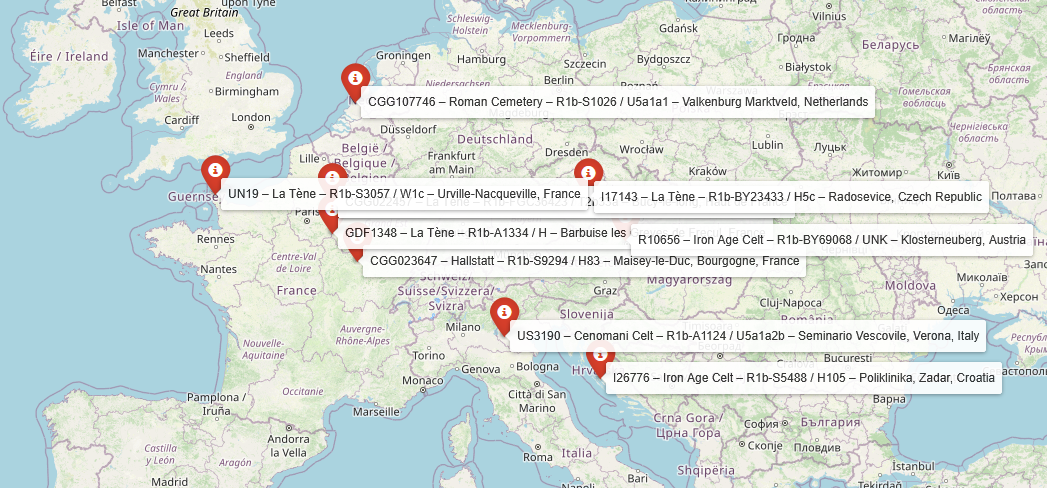R1b-L21, a prominent Y-DNA haplogroup today concentrated in the British Isles, is often seen as a marker of Insular Celtic ancestry. Its presence has been strongly linked to the Bell Beaker expansion and the subsequent rise of Bronze Age cultures in Britain and Ireland. However, new genomic evidence challenges this narrative, placing L21 not only offshore but within the very heart of Continental Iron Age Europe.

New Data: L21 Beyond the Isles
A growing number of L21 subclades have now been identified in Iron Age individuals from France, Italy, the Czech Republic, the Netherlands, Austria, and Croatia, showing that this lineage was not restricted to the British Isles.
| Sample ID | Date | Location | Culture | Y-DNA Subclade | Paper |
|---|---|---|---|---|---|
| CGG023647 | 750-450 BC (context) | Maisey-le-Duc tumulus, Bourgogne, France | Hallstatt | R1b-S9294 | McColl, 2024, Steppe ancestry in western Eurasia and the spread of the Germanic Languages |
| GDF1348 | 500-300 BC | Barbuise les Greves de Frecul, France | La Tene | R1b-A1334 | Fischer, Origin and mobility of Iron Age\nGaulish groups in present-day France\nrevealed through archaeogenomics 2022 |
| CGG022427 | 450-1 BC (context) | Bucy-le-long, Aisne, Haut de France | La Tene | R1b-Y7624 | McColl, 2024, Steppe ancestry in western Eurasia and the spread of the Germanic Languages |
| CGG022457 | 450-1 BC (context) | Bucy-le-long, Aisne, Haut de France | La Tene | R1b-FGC36423 | McColl, 2024, Steppe ancestry in western Eurasia and the spread of the Germanic Languages |
| US3190 | 300-1 BC | Seminario Vescovile, Verona, Italy | Cenomani Celt | R1b-A1124 | Laffranchi, 2024, "Until death do us part". A multidisciplinary\n study onhuman-Animalco-burials fromthe\n Late Iron Age necropolis of Seminario\n Vescovile in Verona (Northern Italy, 3\n rd\n BCE) |
| I17143 | 290-250 BC | Radosevice, Czech Republic | La Tene | R1b-BY23433 | Patterson et al, Large-Scale Migration into Britain During the Middle to Late Bronze Age 2021 |
| UN19 | 120-80 BC | Urville-Nacqueville, France | La Tene | R1b-S3057 (DF13 in FTDNA Discover) | Fischer, Origin and mobility of Iron Age\nGaulish groups in present-day France\nrevealed through archaeogenomics 2022 |
| CGG107746 | 39 BC-114 AD | Valkenburg Marktveld, South Holland, Netherlands | Roman Cemetery | R1b-S1026 | McColl, 2024, Steppe ancestry in western Eurasia and the spread of the Germanic Languages |
| R10656 | 26-407 AD | Necropolis, Klosterneuberg, Austria | Iron Age Celt | R1b-BY69068 | Antonio, 2024, Stable population structure in Europe since the Iron Age, despite high mobility |
| I26776 | 200-400 AD | Poliklinika, Zadar, Croatia | Iron Age Celt | R1b-S5488 | Olalde, 2023, A genetic history of the Balkans\n from Roman frontier to Slavic migrations |
What Does It Mean?
These findings invite us to reconsider the boundaries of the “Celtic Atlantic”, which may have extended far beyond the British Isles, encompassing parts of Gaul, northern Italy, Central Europe, and the Adriatic. L21’s continental footprint suggests:
-
Continuity from the Atlantic Bronze Age: L21 lineages could have spread along the Atlantic façade before the rise of Iron Age cultures.
-
Bidirectional flows: Rather than a one-way migration from mainland Europe to Britain, the Iron Age may have seen movements in both directions — with people, lineages, and ideas flowing back to the continent.
-
Cultural transmission: The presence of L21 among La Tène Gauls hints at deeper biological and cultural links across the Channel.
Focus on the Gauls
Among the Gaulish samples, sites like Bucy-le-Long, Barbuise, and Pech Maho stand out. These individuals lived at the heart of La Tène Europe, where elite networks, warrior aristocracies, and long-distance exchanges flourished. Their L21 ancestry reflects not isolation, but integration in a broader Atlantic identity.
Conclusion: A Wider Celtic Ocean
This new genetic evidence challenges the old dichotomy between Insular and Continental Celts. R1b-L21 was not just a relic of isolated island populations, but a living strand in the genetic fabric of Iron Age Europe. It points to a long history of connectivity, mobility, and exchange, linking Britain, Ireland, and mainland Europe in a shared Atlantic story.
Full dataset available here: Iron Age Continental L21 Spreadsheet
